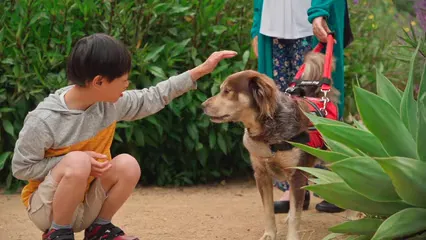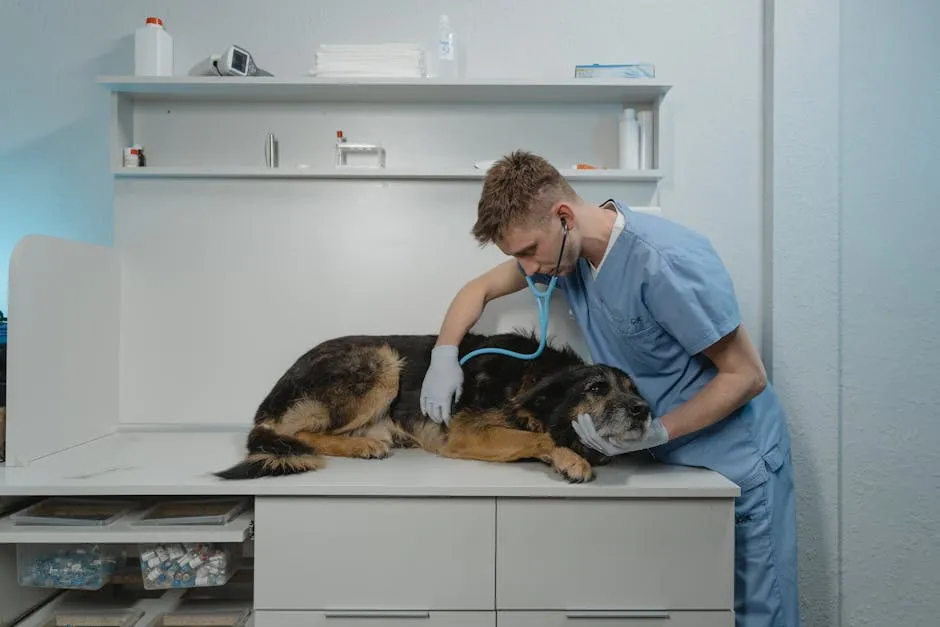Introduction
Autism is a complex condition in humans that affects social interaction and communication. Many wonder if dogs can also exhibit similar traits. This topic is gaining traction in research circles. Experts are exploring how dogs behave and if they show autism-like characteristics. In this article, we will look at signs, causes, and management strategies for canine behavior that resembles autism.
For tips on ensuring a smooth introduction between dogs and babies, check out this helpful guide. tips on ensuring a smooth introduction between dogs and babies 2024
Summary and Overview
Canine Dysfunctional Behavior (CDB) is a term that describes certain behavioral traits in dogs. These traits can be similar to autism in humans. CDB encompasses various signs like social difficulties, repetitive actions, and sensory sensitivities. Understanding these signs is crucial for dog owners. Consulting professionals, such as veterinarians or animal behaviorists, is vital for proper diagnosis and care.

And while you’re at it, why not spoil your furry friend with something fun? The ZippyPaws – Woodland Friends Burrow is perfect for keeping your pup entertained while you ponder the complexities of canine behavior!
Understanding Autism and Canine Dysfunctional Behavior
What is Autism?
Autism Spectrum Disorder (ASD) is a lifelong developmental condition in humans. It affects how individuals communicate and interact socially. People with autism often face challenges in understanding social cues, which can lead to isolation. They may also engage in repetitive behaviors or have specific interests they focus on intensely. Sensory sensitivities are common, where everyday sounds or lights can feel overwhelming.
Can Dogs Experience Autism-like Behaviors?
The concept of Canine Dysfunctional Behavior (CDB) refers to behaviors in dogs that may resemble autism in humans. Research indicates that certain dogs may display signs similar to those of autistic individuals. These behaviors can include social withdrawal, repetitive actions like tail chasing, and heightened sensitivities to stimuli. Ongoing studies aim to better understand the connection between these behaviors and autism. While some experts believe that dogs can have autism-like traits, it is essential to approach this topic carefully. Proper veterinary guidance is crucial for accurate assessments and support for affected dogs.
To help your dog feel more secure during stressful times, consider the ThunderShirt Classic Anxiety Jacket for Dogs. This jacket provides gentle, constant pressure that can help calm anxious pups during thunderstorms or fireworks.

Signs and Symptoms of Canine Dysfunctional Behavior
Common Behavioral Indicators
Identifying signs of canine dysfunctional behavior (CDB) is essential for understanding your dog. Common indicators include social withdrawal, repetitive actions, and communication challenges.
Social withdrawal is when your dog avoids interactions with other pets or people. This might look like your dog hiding when guests arrive or not responding to other dogs during walks.
Repetitive behaviors can manifest in various ways, such as tail chasing, circling, or excessive barking. For example, if your dog consistently spins in circles or fixates on a specific toy, this could be a sign of CDB.
Communication difficulties are also common. Affected dogs may avoid eye contact or struggle to express their needs. Instead of barking or whining, they might become silent or appear disinterested in playtime.
To help with communication and training, a Dog Training Clicker can be a great tool. It helps reinforce positive behavior and improve communication during training sessions.

The Role of Sensory Sensitivities
Dogs with canine dysfunctional behavior may exhibit heightened sensitivity to environmental stimuli. This can lead to distress in situations that others might find normal.
For instance, loud noises like thunderstorms or fireworks can trigger anxiety. Your dog might react by hiding, barking excessively, or even trembling.
Sensitivities can also include textures. Some dogs may refuse to walk on certain surfaces or react negatively to being touched. For example, a dog might shy away from grass or avoid certain fabrics.
Recognizing these sensitivities is crucial for creating a comfortable environment for your dog. By understanding their specific triggers, you can help minimize stress and promote calmness.

The Causes and Triggers of CDB
Genetic and Environmental Factors
Canine dysfunctional behavior may stem from both genetic and environmental influences. Certain breeds might be more prone to these behaviors due to hereditary factors.
Genetic predispositions can affect a dog’s ability to socialize and learn. For example, some breeds may lack mirror neurons, which help dogs learn from their peers. This can lead to challenges in forming social bonds and understanding canine cues.
Environmental factors also play a role. Prenatal exposure to toxins or stress can impact a dog’s development. Puppies exposed to harmful substances may face behavioral issues later in life.

Understanding these factors can guide dog owners in providing the best possible care for their pets. By being aware of genetics and environment, you can make informed decisions about training and support. Additionally, consider providing a cozy place for your dog to relax, like the PetFusion Ultimate Dog Bed, which offers both comfort and support!
Distinguishing CDB from Other Behavioral Issues
Differentiating canine dysfunctional behavior from other conditions is vital for effective treatment. Many symptoms overlap with anxiety or fear-driven behaviors.
For instance, a dog that avoids social interaction may simply be fearful. Observing their reactions in different contexts can provide insights. If your dog shows fear only in unfamiliar settings, it might suggest anxiety rather than CDB.
Repetitive behaviors can also be misleading. While tail chasing may indicate CDB, it could also stem from boredom or lack of stimulation. Engaging your dog in regular activities can help clarify the cause.
Consulting with a veterinarian is key. They can help assess your dog’s symptoms and determine the best course of action. By understanding the distinctions, you can better support your dog’s needs.

Diagnosis and Professional Insights
How is CDB Diagnosed?
Diagnosing Canine Dysfunctional Behavior (CDB) in dogs is a detailed process. It typically begins with a comprehensive veterinary evaluation. A trained veterinarian will observe the dog’s behavior, noting any unusual patterns. They will also conduct a physical examination to rule out medical issues that may appear similar to CDB. Conditions like anxiety or neurological disorders can mimic CDB signs. Therefore, it’s essential to eliminate these possibilities first.
Veterinarians may use behavioral assessments to gauge social interactions and communication skills. This evaluation helps identify repetitive behaviors or heightened sensitivities. Since dogs cannot verbally communicate their feelings, owners play a crucial role. Keeping a detailed record of the dog’s behavior over time can provide valuable insights. This information aids in making an accurate diagnosis.

Professional Opinions on Treatment
Veterinarians and animal behaviorists suggest various treatment options for CDB. One common approach is behavior modification through positive reinforcement. This technique encourages desired behaviors by rewarding them. For instance, if a dog shows social engagement, offering treats can reinforce this positive action. Additionally, regular exercise and mental stimulation are vital components of treatment. Engaging activities help alleviate boredom, which can exacerbate repetitive behaviors.
Some professionals may recommend structured training classes tailored to dogs with CDB. These classes focus on social skills and coping mechanisms. In certain cases, medication may be considered. Anti-anxiety medications can help reduce distress and improve overall behavior. However, medication is typically a last resort, used alongside behavioral strategies for the best outcomes. For those moments when your pup needs a distraction, try the Outward Hound Hide-A-Squirrel Puzzle Toy, which provides mental stimulation and fun!

Managing and Supporting Dogs with CDB
Creating a Supportive Environment
Creating a secure environment is essential for dogs with CDB. Start by designating a calm space where your dog can retreat when feeling overwhelmed. This area should be quiet and free from distractions. Using comfortable bedding or a crate can provide a sense of security. Consistency in your dog’s daily routine is also crucial. Regular feeding times, walk schedules, and play sessions can greatly reduce anxiety.
Limiting exposure to stressful situations, like loud noises or crowded places, is beneficial. Gradually introducing new experiences can help your dog adjust without becoming overwhelmed. Providing a predictable environment fosters a sense of stability, allowing your dog to thrive. Consider adding a PetSafe Drinkwell Platinum Pet Fountain to keep your dog hydrated and happy!

Training Techniques and Behavioral Modification
Training techniques tailored for dogs with autism-like symptoms are vital. Positive reinforcement remains the most effective method. Rewarding good behavior encourages dogs to repeat those actions. Gradually introducing social situations can help your dog learn to engage with others.
Incorporating puzzle toys and interactive games can stimulate your dog’s mind. These activities provide mental challenges that keep your dog engaged and reduce repetitive behaviors. Consistency in training is key; establishing clear commands and expectations helps your dog understand what is required. Patience is essential, as progress may take time. Working with a professional trainer experienced in handling dogs with CDB can also enhance your approach. And for those moments of boredom, don’t forget about the KONG Classic Dog Toy, a timeless favorite for keeping dogs entertained!

Real-Life Experiences and Community Support
Many dog owners have shared their heartfelt stories about raising dogs with Canine Dysfunctional Behavior (CDB). For instance, one owner described how their dog, Max, wouldn’t engage with other pets. At first, they thought it was just Max being shy. However, over time, they noticed he displayed repetitive behaviors, like constantly chasing his tail. This prompted them to seek help.
Community support played a crucial role in their journey. They found online forums where other owners shared similar experiences. This connection offered a sense of belonging and reassurance. They learned about training techniques and resources that made a difference for their dogs.
Moreover, local support groups provided workshops and seminars led by veterinarians and trainers. These gatherings helped owners feel less isolated and empowered them with knowledge. Sharing stories and strategies fosters a sense of solidarity among pet owners navigating similar challenges. You could also consider joining a community that understands your needs, like one focused on dog health and wellness. They might even recommend great products like the Dog First Aid Kit to ensure you’re always prepared!

Conclusion
Understanding Canine Dysfunctional Behavior is essential for all dog owners. Recognizing the signs and seeking professional guidance can lead to better support for affected dogs. It’s crucial to be observant and proactive in caring for your furry friend. By doing so, you can create a nurturing environment that promotes their well-being. Remember, every dog is unique, and with patience, love, and the right resources, they can lead fulfilling lives. And while you’re at it, don’t forget to treat them to something special, like the Dog Treats Variety Pack for a little extra love!

FAQs
Can all dog breeds exhibit autism-like behaviors?
Yes, any dog breed can show behaviors reminiscent of autism. However, certain breeds may display these traits more frequently due to genetic predispositions.
How can I tell if my dog’s behavior is a sign of autism or just a quirk?
Look for persistent behaviors. If your dog consistently avoids social interactions, engages in repetitive actions, or shows heightened sensitivity, it may indicate CDB. Consulting a veterinarian can help clarify your concerns.
Are there specific training methods for dogs with autism-like symptoms?
Yes, there are effective training methods for dogs with autism-like symptoms. Positive reinforcement is a key approach. This method rewards your dog for desired behaviors, making learning enjoyable. For instance, if your dog follows a command or interacts positively, give treats or praise. Tailored training techniques can also help address specific needs. For instance, breaking tasks into smaller steps can make learning easier for your dog. Incorporating mental stimulation through puzzle toys keeps their minds engaged. This combination can lead to a happier, more confident dog.
What should I do if I suspect my dog has CDB?
If you suspect your dog has Canine Dysfunctional Behavior (CDB), consult a veterinarian or animal behaviorist. They can evaluate your dog’s behavior and provide guidance. A thorough assessment helps rule out other conditions that may mimic CDB. It’s important to address your concerns as soon as possible. Early intervention can lead to better outcomes. Be prepared to share specific examples of your dog’s behavior. This information will assist professionals in making an accurate diagnosis and developing a management plan.
Can a change in environment affect a dog’s autism-like behaviors?
Absolutely, a change in environment can significantly impact a dog’s autism-like behaviors. Dogs thrive on routine and stability. Sudden changes, like moving to a new home or introducing new pets, can increase anxiety. This heightened stress may lead to more pronounced behaviors, like withdrawal or repetitive actions. Maintaining a consistent routine helps your dog feel secure. Gradual introductions to new experiences can also ease their adjustment. By providing a stable environment, you can help minimize the impact of changes on your dog’s behavior.
What are some effective management strategies for dogs with CDB?
Managing dogs with CDB involves several strategies that promote their well-being. First, establish a consistent daily routine. Regular feeding, exercise, and playtimes can create a sense of security. Next, create a calm space for your dog to retreat when feeling overwhelmed. This area should be quiet and familiar. Incorporating positive reinforcement training can also encourage desired behaviors. Engage your dog with mentally stimulating toys and activities. Finally, monitor their environment to reduce exposure to stressors. These strategies can significantly improve your dog’s quality of life.
How do I approach professional help for my dog?
Approaching professional help for your dog is straightforward. Start by researching veterinarians or animal behaviorists who specialize in canine behavior. Look for professionals with experience in addressing CDB or similar issues. Once you find potential candidates, schedule consultations. During the visit, share your concerns and provide specific examples of your dog’s behavior. This information will help them understand your dog’s unique situation. Follow their recommendations for treatment or training. Building a strong relationship with your chosen professional can lead to better support for your dog.
Please let us know what you think about our content by leaving a comment down below!
Thank you for reading till here 🙂
All images from Pexels





